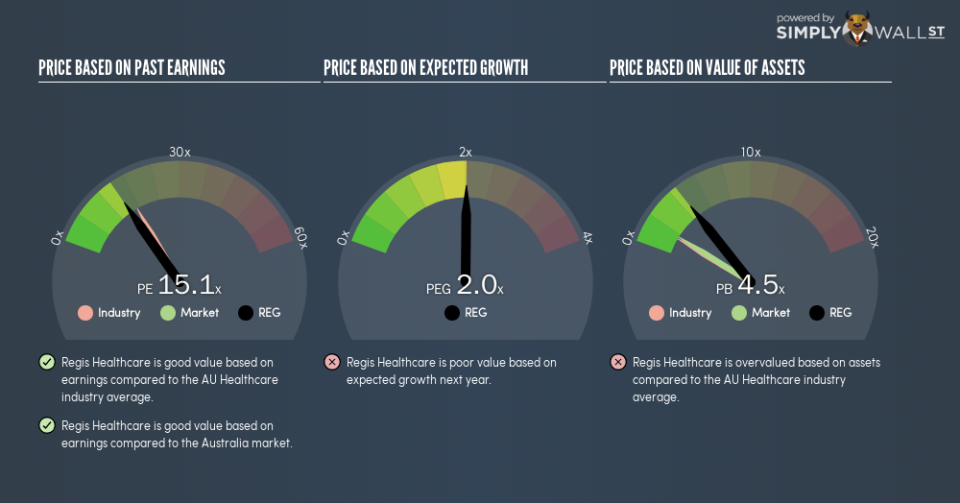Here’s What Regis Healthcare Limited’s (ASX:REG) P/E Ratio Is Telling Us

This article is for investors who would like to improve their understanding of price to earnings ratios (P/E ratios). To keep it practical, we’ll show how Regis Healthcare Limited’s (ASX:REG) P/E ratio could help you assess the value on offer. Regis Healthcare has a price to earnings ratio of 15.12, based on the last twelve months. In other words, at today’s prices, investors are paying A$15.12 for every A$1 in prior year profit.
Check out our latest analysis for Regis Healthcare
How Do You Calculate A P/E Ratio?
The formula for price to earnings is:
Price to Earnings Ratio = Price per Share ÷ Earnings per Share (EPS)
Or for Regis Healthcare:
P/E of 15.12 = A$2.71 ÷ A$0.18 (Based on the trailing twelve months to June 2018.)
Is A High P/E Ratio Good?
A higher P/E ratio means that investors are paying a higher price for each A$1 of company earnings. That isn’t necessarily good or bad, but a high P/E implies relatively high expectations of what a company can achieve in the future.
How Growth Rates Impact P/E Ratios
If earnings fall then in the future the ‘E’ will be lower. That means unless the share price falls, the P/E will increase in a few years. So while a stock may look cheap based on past earnings, it could be expensive based on future earnings.
Regis Healthcare shrunk earnings per share by 12% over the last year. But it has grown its earnings per share by 26% per year over the last five years. And EPS is down 5.1% a year, over the last 3 years. This growth rate might warrant a low P/E ratio.
How Does Regis Healthcare’s P/E Ratio Compare To Its Peers?
The P/E ratio indicates whether the market has higher or lower expectations of a company. The image below shows that Regis Healthcare has a lower P/E than the average (17.2) P/E for companies in the healthcare industry.
Regis Healthcare’s P/E tells us that market participants think it will not fare as well as its peers in the same industry. While current expectations are low, the stock could be undervalued if the situation is better than the market assumes. If you consider the stock interesting, further research is recommended. For example, I often monitor director buying and selling.
Don’t Forget: The P/E Does Not Account For Debt or Bank Deposits
It’s important to note that the P/E ratio considers the market capitalization, not the enterprise value. Thus, the metric does not reflect cash or debt held by the company. Hypothetically, a company could reduce its future P/E ratio by spending its cash (or taking on debt) to achieve higher earnings.
Such spending might be good or bad, overall, but the key point here is that you need to look at debt to understand the P/E ratio in context.
Is Debt Impacting Regis Healthcare’s P/E?
Net debt totals 49% of Regis Healthcare’s market cap. This is enough debt that you’d have to make some adjustments before using the P/E ratio to compare it to a company with net cash.
The Bottom Line On Regis Healthcare’s P/E Ratio
Regis Healthcare has a P/E of 15.1. That’s around the same as the average in the AU market, which is 15.3. With modest debt, and a lack of recent growth, it would seem the market is expecting improvement in earnings.
Investors have an opportunity when market expectations about a stock are wrong. If the reality for a company is not as bad as the P/E ratio indicates, then the share price should increase as the market realizes this. So this free visual report on analyst forecasts could hold they key to an excellent investment decision.
But note: Regis Healthcare may not be the best stock to buy. So take a peek at this free list of interesting companies with strong recent earnings growth (and a P/E ratio below 20).
To help readers see past the short term volatility of the financial market, we aim to bring you a long-term focused research analysis purely driven by fundamental data. Note that our analysis does not factor in the latest price-sensitive company announcements.
The author is an independent contributor and at the time of publication had no position in the stocks mentioned. For errors that warrant correction please contact the editor at editorial-team@simplywallst.com.

 Yahoo Finance
Yahoo Finance 
